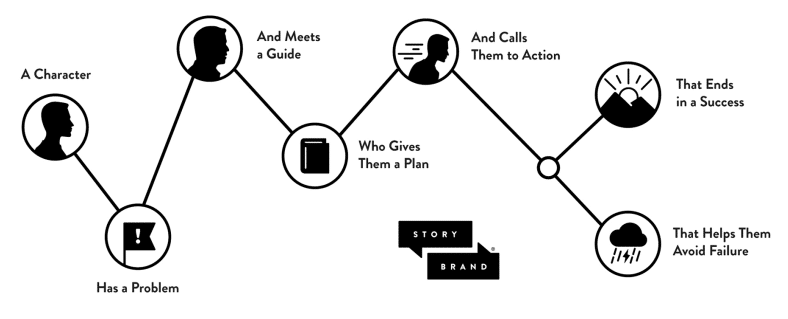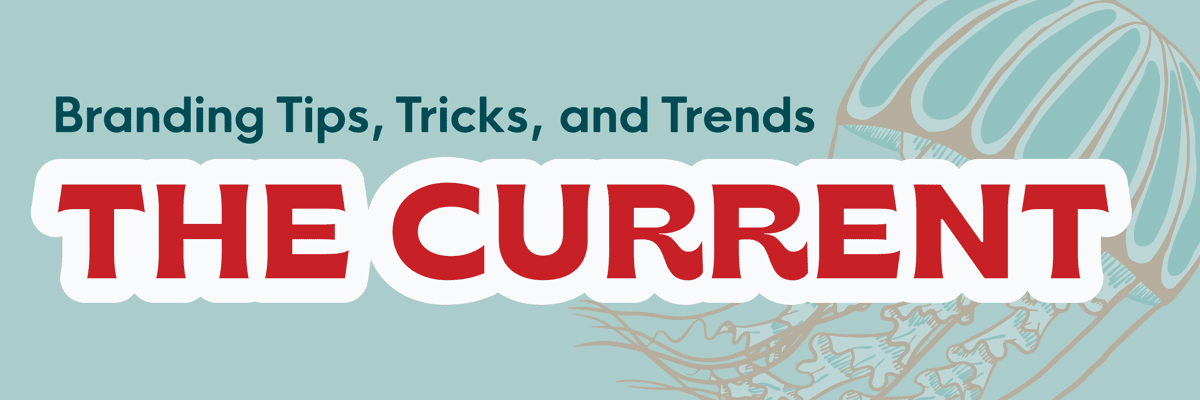In today’s world, customers are constantly bombarded with messages on all sides. With so much noise, it can be hard to make your brand heard. That’s the key goal behind StoryBrand, a strategic messaging matrix created by Donald Miller that is designed to help you tell your brand story. The StoryBrand process follows 7 steps that are known as the SP7 framework.
The StoryBrand Framework

Human beings are wired for stories. There’s a reason that some movies do so well at the box office — they follow the same structure that people have used to tell stories for hundreds of years. The StoryBrand framework uses this same structure to tell your brand story in a way that is engaging and memorable for your future customers. Here are the seven basic steps:
A Character Who Wants Something
The biggest mistake that brands often make is they establish themselves as the hero in the story. They shout messages telling everyone how great they are and forget that their customers aren’t looking for a hero to follow, they’re looking to be the hero. What they really need is a guide to help them get what they want (more on this later).
Understanding your future customers is key to building clear brand messaging. How old are they? What is their gender? What are their jobs? How much money do they make? Most importantly, What do they care about? What do they want? If you can clearly and succinctly answer these questions you can build a solid foundation for your brand messaging.
With a Problem
The next thing you need to understand about your future customers is the problems they are experiencing. Chances are, they are experiencing a whole bunch of different problems so for the sake of clarity it’s important to focus on just one. Choose your position. Are you the skincare company that solves the problems of people who can’t find all-natural products or are you the skincare company that solves the problems of people looking for healing of medical conditions? Are you the business coach who solves the problem of overcomplicated planning with simplicity or are you the business coach who specifically helps solve financial problems.
There are two types of problems you need to be able to define. The first problem is the actual physical problem your company offers a solution to. Those problems might include needing clear, unbiased direction from a business coach or having a skin condition that needs healing.
You also need to be able to define the internal problems that are associated with this external problem. How do your customers feel about this problem? Maybe the man who needs help from a business coach feels overwhelmed and like he has no sense of purpose. Maybe the woman with a skin condition feels embarrassed and is keeping herself from meaningful interaction with friends and family.
Who Meets a Guide
As we mentioned earlier, your customer wants to be their own hero but they are looking for a guide. In this step of the framework, you want to establish your brand as the Yoda to their Luke Skywalker or the Dumbledore to their Harry Potter.
There are two important parts in establishing yourself as a guide: demonstrating empathy and authority. To demonstrate empathy you need to show your character that you really care. If you were a clothing company focused on inclusive sizing options you might say, “we know it can be difficult to find clothes you feel comfortable in.”
Next, you demonstrate authority by showing why you’re qualified. You might mention that a large number of people have already used and loved your product or service. You might mention how many years you’ve been in business. You might state specific parts of your business that are unique and make you better than all competitors. The important thing here, as in the rest of your messaging, is to keep it simple and direct!
Who Gives Them a Plan
The simple truth is that if people understand and can visualize a process they are much, much more likely to engage with it. It’s the old marketing messaging that “it’s as easy as one, two, three.” But the thing is anything can be as simple as one, two, three. When you show your customers a clear plan they will have less uncertainty and fear about doing business with you. For example, your plan might be: order your product, use the product, experience the change you’re looking for. Obviously, you want your plan to be more specialized than this and to highlight the important steps in your individual process but the most important thing here is to keep it simple, as we’ve been saying.
And Calls Them To Action
This is the simplest part of the framework. What do you ultimately want your customer to do? Set up a free consultation? Download your app? Contact you today? Make this something clear and easy that can be done right away.
That Helps Them Avoid Failure
What misfortunes are you helping your customers avoid when they work with you? This can be pretty simple, it’s essentially the opposite of what the customer wants. Demonstrate clearly that by not engaging with your brand your customers will be stuck continuing to live with the same problems they are living with now.
And Ends in Success
This is the most important part of the whole framework. You want to clearly illustrate for your future customers what their lives will look like after engaging with you. You want to directly address how you have solved their problems and how that changes their lives, illustrate this clearly with concrete details, and show how they have been transformed. At the end of the day, we are all looking for a transformation in our lives. If you have a clear idea of how your business helps people, then tell your customers clearly what that looks like.
How Do You Build a Brand Story For Your Business?
Now you may be thinking to yourself that this all seems interesting but how do you know how to build a brand story that is effective and powerful for your own business? This is where Big Red Jelly comes in. Our team of brand specialists know how to help make your brand engaging and memorable for your future customers. Our branding packages include not only visuals for your brand but also this core brand messaging that can be used on any future marketing materials. We provide a variety of different branding packages depending on your needs that may include a logo, Style Guide (primary logo, alternative logo, color palette, typography, full brand story, value propositions, mission statement, tagline, social media branding, GoogleMyBusiness branding, and much more.
Schedule a free strategy call today to learn how your brand can tell its story in a way that keeps customers coming back.







